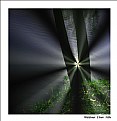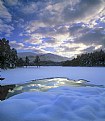Creating colours on a black and white silver gelatine image is a vast subject. Some of the techniques which may be employed are as follows:
1) Bleach and redevelop. Using different halogen bleaches - chloride, iodide, bromide, then redeveloping with a variety of reducing agents, not just normal photographic developer, a whole new range of print colorations many be achieved. Ascorbic acid, ferrous sulphate, sodium dithionite, stannous chloride are among the more interesting redevelopment agents. Some of the most interesting effects are obtained using differential solvation on redevelopment.
2) Toning has already been alluded to in the answers above.
Metal Toning:
Iron toning can produce blues, yellows and diffusable red. Nickel - yellows, reds and (with iron) greens.
Lead - deep blacks (lead selenosulphide), browns, red browns and yellows.
Titanium - orange yellows, greens with iron
Vanadium - primrose yellows, greens with iron.
Gold - subtle blues and reds. Mike Ware's gold printing processes give a whole range of colours from pure gold.
Lead sulphochloride - red browns.
Copper - reds, browns, pinks.
Non metallic toning:
Sulphide - range of yellows to browns.
Selenium - violets, purples, oranges and reds.
Chromogenic Development:
Dye coupling with colour developers - virtually any colour by mixing proportions of different colour formers.
Tin development process:
Blues, greens, yellows, oranges, browns. Pastel salmon pinks and reds when combined with traces of copper. Also diffusion (chemical soft focus effects) and partially reflective (kinetic) films.
Differential gelatine dyeing with or without gelatine hardening gives whacky or subtle effects. Some dyes stain unhardened gelatine, others only hardened gelatine. Hardening may be achieved by development or special bleaches.
Of course masking with paint-on fluids can combine and localise techniques on one print but it is a very tedious and time consuming process.
|
















